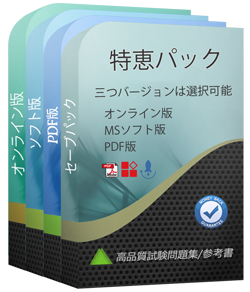あなたのテストエンジンはどのように実行しますか?
あなたのPCにダウンロードしてインストールすると、IBM LOT-922テスト問題を練習し、'練習試験'と '仮想試験'2つの異なるオプションを使用してあなたの質問と回答を確認することができます。
仮想試験 - 時間制限付きに試験問題で自分自身をテストします。
練習試験 - 試験問題を1つ1つレビューし、正解をビューします。
LOT-922テストエンジンはどのシステムに適用しますか?
オンラインテストエンジンは、WEBブラウザをベースとしたソフトウェアなので、Windows / Mac / Android / iOSなどをサポートできます。どんな電設備でも使用でき、自己ペースで練習できます。オンラインテストエンジンはオフラインの練習をサポートしていますが、前提条件は初めてインターネットで実行することです。
ソフトテストエンジンは、Java環境で運行するWindowsシステムに適用して、複数のコンピュータにインストールすることができます。
PDF版は、Adobe ReaderやFoxit Reader、Google Docsなどの読書ツールに読むことができます。
割引はありますか?
我々社は顧客にいくつかの割引を提供します。 特恵には制限はありません。 弊社のサイトで定期的にチェックしてクーポンを入手することができます。
あなたはLOT-922試験参考書の更新をどのぐらいでリリースしていますか?
すべての試験参考書は常に更新されますが、固定日付には更新されません。弊社の専門チームは、試験のアップデートに十分の注意を払い、彼らは常にそれに応じてLOT-922試験内容をアップグレードします。
購入後、どれくらいLOT-922試験参考書を入手できますか?
あなたは5-10分以内にIBM LOT-922試験参考書を付くメールを受信します。そして即時ダウンロードして勉強します。購入後にLOT-922試験参考書を入手しないなら、すぐにメールでお問い合わせください。
更新されたLOT-922試験参考書を得ることができ、取得方法?
はい、購入後に1年間の無料アップデートを享受できます。更新があれば、私たちのシステムは更新されたLOT-922試験参考書をあなたのメールボックスに自動的に送ります。
返金するポリシーはありますか? 失敗した場合、どうすれば返金できますか?
はい。弊社はあなたが我々の練習問題を使用して試験に合格しないと全額返金を保証します。返金プロセスは非常に簡単です:購入日から60日以内に不合格成績書を弊社に送っていいです。弊社は成績書を確認した後で、返金を行います。お金は7日以内に支払い口座に戻ります。
Tech4Examはどんな試験参考書を提供していますか?
テストエンジン:LOT-922試験試験エンジンは、あなた自身のデバイスにダウンロードして運行できます。インタラクティブでシミュレートされた環境でテストを行います。
PDF(テストエンジンのコピー):内容はテストエンジンと同じで、印刷をサポートしています。
IBM Developing IBM Lotus Domino 8.5.2 Applications: Advanced XPage Design 認定 LOT-922 試験問題:
1. John wishes to add a managed bean to his application. In order to do this he must do which of the following:
A) Create a JavaBean class and add the Java class as a page resource to the XPage where the managed bean is to be used.
B) Open the pre-existing faces-config.xml file located at WebContent\WEB-INF\faces-config.xml
and add the appropriate markup to the file.
C) Create a file called xpages-config.xml within his application and define the managed bean within the file using the appropriate syntax.
D) Open the pre-existing xpages-config.xml file located at WebContent\WEB-INF\xpagesconfig.xml and add the appropriate markup to the file.
2. Jeremy wants all of the dijit.Dialog boxes in his application to call a client side JavaScript function called "validateForm" whenever they are hidden. What is the best solution?
A) Create a custom Dojo control and use that instead of the standard dijit.Dialog in the application
using the following code:
/**
*Custom Dojo Control
*/
dojo.provide('com.myco.widget.Dialog');
dojo.require('dijit.Dialog');
(function(){
dojo.declare("com.myco.widget.Dialog", dijit.Dialog, {
onHide: validateForm
})
}());
/**
*Initialization code
*/
var dialog = new com.myco.widget.Dialog();
B) Create a custom Dojo control and use that instead of the standard dijit.Dialog in the application
using the following code:
/**
*Custom Dojo Control
*/
dojo.provide('com.myco.widget.Dialog');
dojo.require('dijit.Dialog');
(function(){
dojo.declare("com.myco.widget.Dialog", dijit.Dialog, {
onHide: validateForm
})
}());
/**
*Initialization code
*/
var dialog = new dijit.Dialog();
C) Create a custom Dojo control and use that instead of the standard dijit.Dialog in the application
using the following code:
/**
*Custom Dojo Control
*/
dojo.provide('com.myco.widget.Dialog');
dojo.require('dijit.Dialog');
(function(){
dojo.declare("com.myco.widget.Dialog", dijit.Dialog, {
onHide: validateForm
})
}());
/**
*Initialization code
*/
var dialog = new com.myco.widget.Dialog();
D) Create a custom Dojo control and use that instead of the standard dijit.Dialog in the application
using the following code:
/**
*Custom Dojo Control
*/
dojo.provide('com.myco.widget.Dialog');
dojo.require('dijit.Dialog');
(function(){
dojo.declare("com.myco.widget.Dialog", dijit.Dialog, {
onHide: validateForm
})
}());
/**
*Initialization code
*/
var dialog = new com.myco.widget.Dialog();
E) Whenever he initializes a new dijit.Dialog, add an onHide event like so:
var dialog = new dijit.Dialog({
onHide: validateForm
}
);
F) In the "Close" or "Cancel" button of each dialog add a call to validateForm in the onClick event.
G) Create a custom Dojo control and use that instead of the standard dijit.Dialog in the application
using the following code:
/**
*Custom Dojo Control
*/
dojo.provide('com.myco.widget.Dialog');
dojo.require('dijit.Dialog');
(function(){
dojo.declare("com.myco.widget.Dialog", dijit.Dialog, {
onHide: validateForm
})
}());
/**
*Initialization code
*/
var dialog = new com.myco.widget.Dialog();
3. John wishes to add a Java Class to his XPages application. How would he do this?
A) Expand his application in the "Applications Navigator" and create a new Java Agent, place the necessary Java logic within the agent, and call the agent from within the XPage
B) Switch to the Java Perspective, navigate to the "Local" Java Source Folder within the application (using the Package Explorer), and create the Java Class within that folder
C) Switch to the Java Perspective and create a new Java Source Folder within the application (using the Package Explorer), and create the Java Class within that folder
D) Expand his application in the "Applications Navigator" and create a new Java Script Library and place the necessary Java logic within that script library?
4. Brandon wants to extend Dojo's dijit.Dialog box to add some extra functionality. How would Brandon declare the new Dojo class?
A) dijit.declare("brandons.Dialog", "dijit.Dialog", { // added functionality });
B) dijit.declare("brandons.Dialog", dijit.Dialog, { // added functionality });
C) dojo.declare("brandons.Dialog", dijit.Dialog, { // added functionality });
D) dojo.declare("brandons.Dialog", "dijit.Dialog", { // added functionality });
5. Elizabeth needs to parse the contents of a web page held on a remote server into an applicationScope variable via the server side onclick event of a button using Server Side JavaScript. How would she do this?
A) Create a new Java class to perform the operation in a Java Script Library and call it from the onclick event of the button.
B) It is not possible to perform network operations from Server Side JavaScript
C) Create a new Java class to perform the operation in the WebContent\WEB-INF\src folder via the Package Explorer and call it from the onclick event of the button.
D) Create a new Java class to perform the operation in a Java Agent and call it from the onclick event of the button.
質問と回答:
| 質問 # 1 正解: B | 質問 # 2 正解: A、C、D、G | 質問 # 3 正解: C | 質問 # 4 正解: C | 質問 # 5 正解: C |


 弊社は製品に自信を持っており、面倒な製品を提供していません。
弊社は製品に自信を持っており、面倒な製品を提供していません。



 -Akiyoshi
-Akiyoshi

